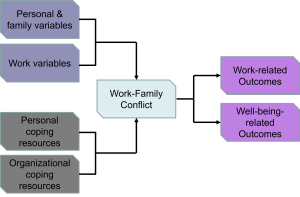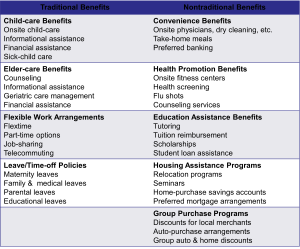12-3: Work-Family Balance

Work-family balance represents a critical domain of worker well-being that investigates how satisfaction and experiences in work and non-work spheres influence each other (Zedeck, 1992). For many people, non-work life centers around family responsibilities, making work-family interactions particularly important for overall well-being. Your physical and psychological well-being suffer when life becomes unbalanced, with excessive time and energy invested in one sphere at the expense of others.
Here’s the thing about work-family balance: it’s not just about time management or being more organized. It’s about the fundamental challenge of being a whole person with multiple important roles and responsibilities. You might be an employee, but you’re also potentially a parent, spouse, child to aging parents, friend, and community member. All of these roles matter, and they all make legitimate demands on your time and energy.
Group Factors in Work-Family Balance
Team norms significantly influence work-family balance in ways you might not even realize. Teams that normalize excessive overtime, constant availability, or weekend work create environments where maintaining family commitments becomes incredibly difficult. Have you ever worked somewhere where people actually bragged about how many hours they worked or how little sleep they got? Those are seriously unhealthy team norms that can destroy work-family balance for everyone.
Think about it: when your team culture rewards face-time over productivity, or when people get praised for responding to emails at midnight, it creates pressure for everyone to sacrifice their personal lives to look committed. It becomes this toxic competition of who can be the most work-obsessed.
Conversely, teams that model and support healthy boundaries can enhance work-family balance for all members. When your team leader says, “Don’t check email after 6 PM,” and actually means it — when they don’t send emails after hours and don’t expect responses — that creates a norm that benefits everyone. It gives people permission to have lives outside of work.
Virtual teams present unique challenges and opportunities for work-family balance that have become especially relevant in our increasingly connected world. While virtual work can provide flexibility that supports family responsibilities (no commute, ability to handle family emergencies), it can also blur boundaries between work and home life in problematic ways. When virtual teams lack clear communication protocols or have members across multiple time zones, the expectation for constant availability can severely impact family time.
Ever tried to have dinner with your family while wondering if you should be checking your work messages? That’s the boundary blur that virtual work can create, and it’s particularly stressful when team norms don’t address these issues clearly.

Models of Work-Family Interaction
Several theoretical models explain the relationships between work and family domains, with group factors playing important roles in each. Understanding these models can help you make sense of your own experiences and figure out strategies for managing the intersection of work and personal life.
The Spillover Model proposes that attitudes and behaviors carry over from one domain to the other, creating either positive enrichment effects or negative conflict effects (Edwards & Rothbard, 2000). Team culture significantly influences this spillover — positive team experiences can enhance your family interactions, while team conflicts can create negative spillover that affects your relationships at home. Ever notice how a great day at work can put you in a fantastic mood at home, or how family stress can make it nearly impossible to concentrate during team meetings?
The Conflict Model focuses on situations where work and family demands are incompatible, creating stress as you struggle to meet competing obligations (Greenhaus & Beutell, 1985). Group demands such as mandatory team meetings outside normal hours or team projects with unrealistic deadlines can seriously exacerbate work-family conflict. When your team expects you to be available for a “quick” meeting at 7 PM, that directly conflicts with family dinner time.
The Compensation Model suggests that work and family domains operate in a counterbalancing manner, with deficits in one area compensated by increased investment in the other area (Edwards & Rothbard, 2000). Team support can help individuals navigate this compensation by providing flexibility when family demands increase. When your team covers for you during a family crisis, it allows you to focus on what’s needed at home without completely sacrificing your work responsibilities.
The Segmentation Model proposes that work and family issues remain separate with minimal overlap, though this model appears less applicable to modern work environments where boundaries between domains have become increasingly blurred, particularly in team-based work that extends beyond traditional hours. With smartphones, remote work, and global teams, when does work really end? The old 9-to-5 boundaries that made segmentation possible have largely disappeared.
Family Supportive Supervisor Behaviors (FSSB)
One particularly important development in work-family research is the Family Supportive Supervisor Behaviors (FSSB) measure developed by Hammer and colleagues (2009). This scale demonstrated incremental validity over more general social support measures in predicting various outcomes related to work-family balance, job satisfaction, and turnover intentions.

A family supportive supervisor is one who values and appreciates an employee’s desire to find balance between work and family responsibilities. Research shows that FSSB training actually impacts employees — those who perceived family-specific support from trained supervisors reported greater job satisfaction and lower turnover intentions.
This research highlights how team leadership and supervisor behavior directly impact individual well-being through specific, trainable behaviors that acknowledge and support the whole person rather than just the employee role.
Work-Family Balance & Organizational Support: 2017 National Study of Employers
Organizational flexibility and a supportive work-family culture was positively related to:
- Employee engagement
- Job satisfaction
- Intentions to stay with employers
- Less negative spillover from work to home and from home to work
- Better mental health
Emerging trends from 2012 to 2017 show employers providing more day-to-day flexibility:
- Increase in telework options, allowing employees to work at least some hours at home (40% in 2016 vs. 33% in 2012)
- Increase in gradual return-to-work after childbirth/adoption (81% in 2016 vs. 73% in 2012)
- Increase in special consideration after career breaks for personal/family reasons (28% in 2016 vs. 21% in 2012)
- Decrease in organizations allowing time off during workday for personal/family needs without pay loss (81% in 2016 vs. 87% in 2012)
Family-Friendly Benefits and Organizational Supports
Modern organizations offer various work-life supports that directly impact employee well-being:
Parental Leave Programs enable employees to combine work and family responsibilities related to child rearing. These programs recognize that supporting employees during major life transitions benefits both individuals and organizations.
Family-Leave Policies allow employees to take time off for family issues beyond just childbirth. The Family and Medical Leave Act (FMLA) provides up to 12 weeks of unpaid leave for family-related issues, though it’s primarily used by workers aged 18-34 for personal health and childbirth. A major limitation of U.S. policy is that many employees can’t afford to use unpaid leave, unlike European countries with stronger paid leave programs such as Belgium’s career break program.
Child-Care Benefits have become prominent in American organizations as both recruitment tools and valuable resources for employees who can use them. Lotus Software provides a compelling example: they experienced only 4-5% turnover among employees using company child-care compared to the 18% industry average. Research links on-site child-care to higher job satisfaction and organizational commitment.
However, child-care benefits also create potential “family-friendly backlash” from childless employees, exemplified by groups like the ChildFree Network that question why childless people should help fund benefits they can’t use.
Elder-Care Assistance addresses a growing need, as 22 million U.S. households provide care to elderly relatives. The typical caregiver is a 46-year-old employed woman (usually a daughter) spending 18 hours per week caring for her mother. Many of these caregivers are part of the “Sandwich Generation” — 41% also care for children under 18, creating tremendous stress from competing demands.
With the population over 65 expected to double between 2000 and 2030, elder-care needs will only increase. Currently, 75% of employers offer some elder-care services, recognizing the huge costs to organizations through absenteeism, interruptions, emergencies, and turnover when employees lack adequate support.
Dual-Earner Couples: Navigating Modern Work-Family Dynamics
Dual-earner couples — where both partners are employed and maintain a family — represent a significant portion of the modern workforce (approximately 45% in 1998). These couples face unique challenges as work has become home and home has become work, creating faster-paced lives with complex competing demands.
Research reveals two distinct patterns in dual-career marriages:
Conventional Dual-Career Marriage: The female maintains primary responsibility for home and children while adding career responsibilities. This creates significant strain as women essentially work two full-time jobs — one paid and one unpaid.
Role-Sharing Dual-Career Marriage: Both spouses are active in careers and home responsibilities. Women expecting role-sharing marriages tend to be more committed to lifelong careers, have higher self-esteem, and expect husbands to be genuinely involved in household management rather than just “helping.”
Crossover effects occur in dual-earner couples, where stress transmits from one partner to the other, creating spillover that affects both individuals’ well-being. Variables affecting career satisfaction in these couples include satisfaction with child-care arrangements, job security levels, time pressures at work, and supervisor-subordinate relationship quality.
The work-family balance challenge for dual-earner couples extends beyond individual stress management to require coordination, communication, and shared responsibility systems that support both partners’ career and family goals.
Work-Family Conflict and Its Impacts
Work-family conflict represents a bidirectional phenomenon where demands from work interfere with family responsibilities or family demands interfere with work obligations. Research consistently demonstrates associations between work-family conflict and reduced job satisfaction, life satisfaction, and job performance, along with increased anxiety and substance abuse (Kossek & Ozeki, 1998). In other words, when these domains conflict, everything suffers.
Key statistics highlight the scope of work-family challenges:
- 78% of women with children between 6-17 are employed outside the home
- 78% of employees surveyed indicate their #1 priority is balancing work and family life
- The relationship between work-family conflict and career satisfaction is stronger for women (r = -.23) than men (r = -.07), reflecting different social expectations and responsibilities
Life Management Theory suggests that flexibility with goals and strategies leads to less work-family conflict, emphasizing the importance of adaptive approaches rather than rigid time management.
Team factors can either exacerbate or reduce work-family conflict in significant ways. Teams with inflexible schedules, frequent crisis situations, or cultures that reward face-time over productivity tend to increase conflict. Think about teams where “emergency” meetings happen regularly, or where people are expected to be available 24/7 “just in case.” These teams make it nearly impossible to maintain healthy family relationships.
On the flip side, teams that offer schedule flexibility, cross-training to provide coverage, and results-oriented cultures tend to reduce conflict. When your teammates can cover your responsibilities during your kid’s school play, or when your team judges success by outcomes rather than hours logged, work-family balance becomes much more achievable.
Work-family enrichment represents the positive side of work-family interactions, where experiences in one domain enhance functioning in the other domain. Team experiences that develop leadership skills, emotional intelligence, or problem-solving abilities can transfer beneficially to family situations (Ruderman et al., 2002). The communication skills you learn from managing team conflicts can help you navigate family disagreements more effectively. Similarly, family experiences that develop patience, empathy, or time management skills can enhance your team functioning.

Media Attributions
- Bullying © Mohamed Hassan is licensed under a Public Domain license
- Conceptual Model of Work-Family Conflict adapted by Jay Brown
- Gender Equality © Kwamikagami is licensed under a CC BY-SA (Attribution ShareAlike) license
- Benefits
